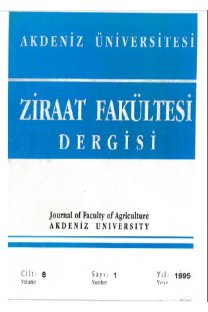Characterization of Turkish sesame (Sesamum indicum L.) landraces using agronomic and morphologic descriptors
Bu çalışmada, 52 adet Türk orijinli yerel susam (Sesamum indicum L.) çeşitlerinin genetik farklılığı, agro-morfolojik özelliklere dayanarak çok değişkenli analiz ile tahmin edilmiştir. Populasyonlar çiçeklenme zamanı, dallanma, yaprak koltuğundaki kapsül sayısı, kapsüldeki karpel sayısı, tohum kabuğu rengi, kapsül tüylülüğü, kapsül di/ilişi, ilk kapsül yüksekliği, bitki boyu, kapsüldeki tohum sayısı, ana saptaki tohum sayısı, tüm bitkideki kapsül sayısı ve 100 tane ağırlığı kullanılarak değerlendirilmiştir. Bu veri seti toplam varyansın % 79 'unun açıklandığı 6 temel bileşen (PC) skoruna dönüştürülmüştür. Kalan 6 PC skoru, hierarşıkıl kümeleme analizinde (Ward'sın minimum vanyans metodu) veri olarak kullanılmıştır. Populasyonlar benzerlik düzeylerine göre 4 ana grupta kümelenmiştir. Kümeleme analizinde, Güney, Güneydoğu ve Batı bölgelerine ait populasyonlarm pekçoğu adapte oldukları bölgelerin dışında kümelenme göstermişlerdir. Bununla birlikte Kuzeybatı (Trakya) bölgesi populasyonlan coğrafik orjinlerine göre bir dağılım göstermişlerdir. Bu çalışına Türk susam populasyonlaruıın genetik yapısı hakkında ıslahcna bilgi vererek bitki İslahında ebeveny seçiminde kullanabilmesi için yardımcı olabilir.
Anahtar Kelimeler:
susam, niceliksel özellikler, bitki genetik kaynakları, genetik farklılık, Sesamum indicum
Türk susam (Sesamum indicum L.) yerel çeşitlerinin agronomik ve morfolojik tanımlayıcılar kullanılarak karakterize edilmeleri
In this study, genetic diversity for agro-morphological traits in 52 landraces of sesame (Sesamum indicum L.) originated from Turkey was estimated through multivahate analysis. Populations evaluated for time to flowering, branching, capsule number per axil, carpel number per capsule, seed coat colour, capsule pubescence, capsule order, plant height to first capsule, plant height, number of seeds per capsule, number of capsules on main stem, total number of capsules per plant and 100 seed weight. This data set was reduced to 6 significant principle components (PCs) that cumulatively explained 79% of the variance. The 6 retained PC scores were used as input for hierarchical cluster analysis (Ward's minumum variance). The populations were clustered in 4 different major groups according to their similarity levels. In cluster analysis most of the populations of the South, Southeast and West regions tended to cluster as outliers outside their region of adaptation. However, the distribution of Nortwest region populations was according to their geographic origin. This study can help breeders better understand the genetic structure of Turkish sesame populations which can be used for parental selection.
___
- Brown, J.S., 1991. Principal Component and Cluster Analyses of Cotton Cultivar Variability across the U.S. Cotton Belt, Crop Sci. 31: 915-922.
- Demir, I., 1962. An Investigation of the Main Morphological, Biological and Cytological Characteristics of Important sesame Species Grown in Turkey. Ege Univ. Press, Izmir, Turkey.
- Diaz, A.J.P., 1999. Layrisse, A. and Pugh, T.M. Analisis de La Diversidad Genetica En El Ajan joli Mediante Electroforesis de isoenzimes. Agron. Tropical. 49(2):169-186.[in Spanish, English abstract.].
- Escribano, M.R., Santalla, M., Casquero, P.A. and DeRon, A.M., 1998. Patterns of Genetic Diversity in Landraces of Common Bean (Phaseolus vulgaris L.) from Galicia. Plant Breed. 117: 49-56.
- FAO. 1998. Quarterly Bulletin of Statistics. ¾, Vol:11.
- Ganesh, S.K. and Thangavelu, S., 1995. Genetic Divergence in Sesame (Sesamum indicum L.). Madras Agric. J. 82(4): 263-265.
- Harch, B.D., Basford, K.E., DeLacy, L.H. an Lawrence, P.K., 1997. The Analysis of larg Scale data Taken From The World Groundnu (Arachis hypogaea L.) Germplasm Collection Two-way Quantitative Data. Euphytica. 95: 27-38.
- Hair, J.F., Jr., Anderson, R.E. and Tatham, R.L., 1987 Multivariate data analysis with readings. Macmillan Publ. Co., New York,NY. Johnson, R.A. and Wichern, D.W., 1998. Applie multivariate Statistical
- Analysis. 2nd. Ed. Prentice-Hall, Englewood Cliff NJ.
- Jolliffe, I.T.,1986. Principal component analysi Springer Verlag, New York, NY.
- Loi, A., Cocks, P.S., Howieson, J.G. and Carr, J 1997. Morphological Characterization o Mediterranean Populations of Biserrula pelecinu L. Plant Breed. 116: 171-176.
- Patil, R.R. and Sheriff, R.A., 1994. Geneti Divergence in Sesame (Sesamum indicum L. Mysore J. Agric. Sci. 28: 106-110.
- Perry, M.C. and McIntosh, M.S., 1991. Geographica Patterns of Variation in the USDA Soybea Germplasm Collection: I. Morphological Trait Crop Sci. 31: 1350-1355.
- Royo, C., Soler ,C. and Romagosa, I., 1995 Agronomical and Morphological Among Winte and Spring Triticales. Plant Breed. 114: 413-416.
- SAS, 2000. Sas Institute. JMP Software SAS Campu Drive, Cary, NC.
- Singh, S.P., Gutièrrez, J.A., Molina, A., Urrea ,C. an Gepts, P., 1991. Genetic Diversity in Cultivate Common Bean: II. Marker-Based Analysis o Morphological and Agronomic Traits. Crop Sc 31: 23-29.
- Souza E. and Sorrels, M.E., 1991. Relationship Among 70 North American Oat germplasm: Cluster Analysis Using Quantitative Character Crop Sci. 31: 599-605.
- van Beuningen, L.T. and Busch, R.H., 1997. Genetic Diversity Among North American Spring Wheat Cultivars: III. Cluster Analysis Based on Quantitative Morphological Traits. Crop Sci. 37: 981-988.
- ISSN: 1301-2215
- Yayın Aralığı: 2
- Başlangıç: 1983
- Yayıncı: Akdeniz Üniv. Ziraat Fak.
